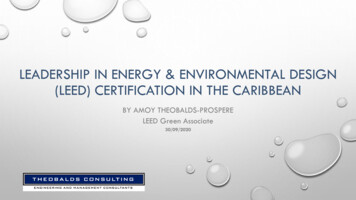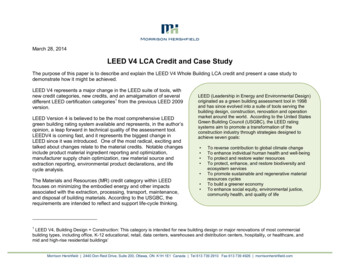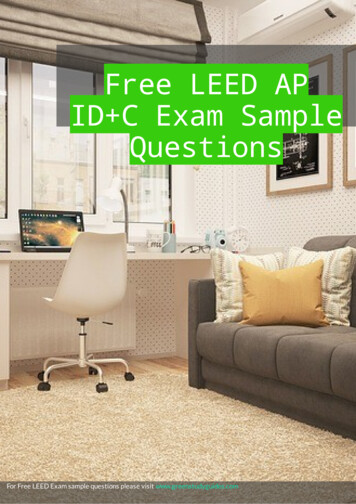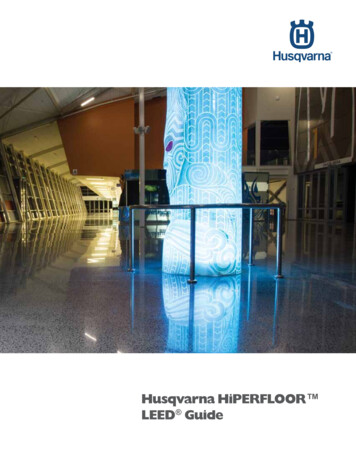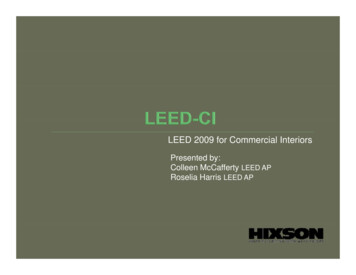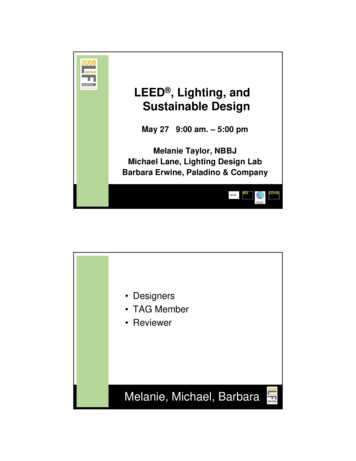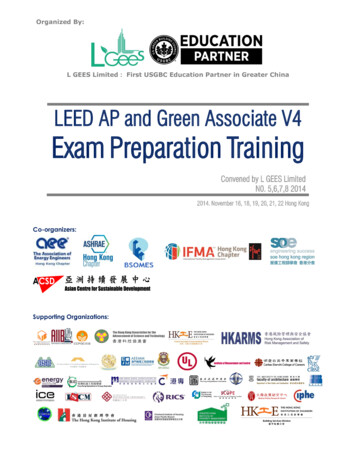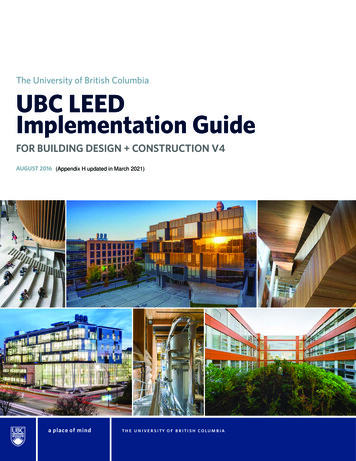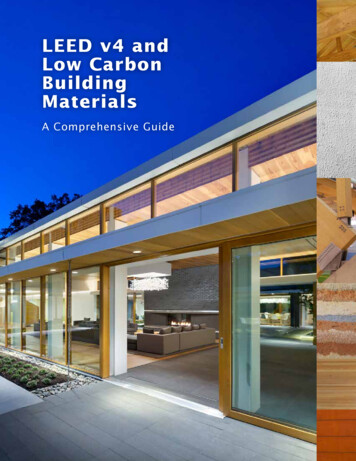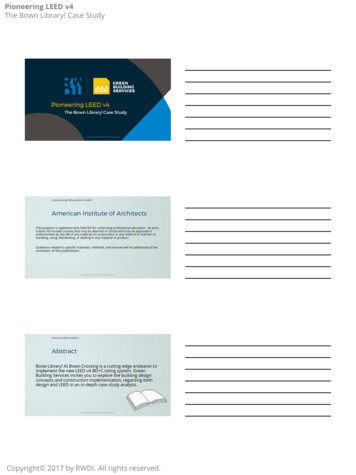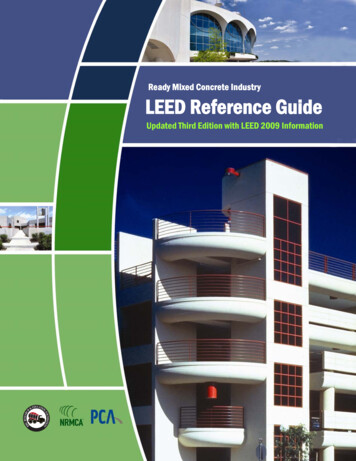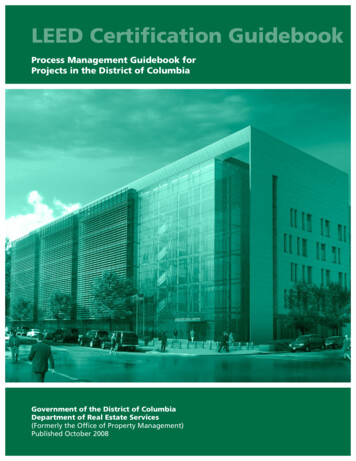
Transcription
LEED Certification GuidebookProcess Management Guidebook forProjects in the District of ColumbiaGovernment of the District of ColumbiaDepartment of Real Estate Services(Formerly the Office of Property Management)Published October 2008
The mission of the Department of Real Estate Services (DRES) is to support the DistrictGovernment and residents through strategic real estate management, construction andfacilities management. It is compromised of four core divisions:Construction: The Construction Division strives to support the efficient provision of government services throughhigh quality and efficient stewardship of constructed assets.Portfolio: The Portfolio Division seeks to achieve the most efficient use of the District-owned property bymaximizing its application for agency facilities and reducing dependence on leased space.Facilities: The Facilities Division aims to provide a clean, safe and operational work environment for Districtagencies through maintenance, custodial, and repair services.Protective Services: The Protective Services Division is committed to creating an atmosphere of safety in DistrictGovernment facilities to ensure that all government employees and residents may conduct business without fearof harm.
PurposeThis Guidebook was commissioned by the District of Columbia Department of Real Estate Services (DRES) in orderto assist DRES’s Project Managers as well as external Architecture and Engineering service providers and Contractorswith achieving LEED Certification as required by the District of Columbia Green Building Act. It is intended to provideguidance, to facilitate the LEED process and to assist project teams in making sound economic and environmentaldecisions for LEED projects. It is not intended to replace the LEED Reference Guides, which are all essential toolswhen designing and building a project under the LEED Rating System, nor is it intended to replace the services of asustainable design consultant, should the project scope or complexity benefit from outside expertise. This Guidebookis intended to provide greater insight into the LEED process specifically for projects located in the District of Columbia.The Leadership in Energy and Environmental Design (LEED) Rating System was developed by the United States GreenBuilding Council (USGBC) and the term “LEED” is trademarked. It should not be used to describe projects that are notRegistered with the USGBC, Certified by the USGBC or not intending to pursue LEED Certification. All LEED-relatedmaterials, such as the LEED Reference Guides, are copyrighted and should not be copied or distributed withoutpermission from the USGBC.At the time of publication of this Guidebook, the LEED Rating Systems referred to are: LEED for New Construction and Major Renovations v2.2 LEED for Commercial Interiors v2.0 LEED for Core and Shell v2.0 LEED for Existing Buildings: Operations and Maintenance LEED for Schools LEED for HomesCurrent LEED Rating Systems will be updated in 2009. All projects registered for LEED with the USGBC beforeupdated Ratings Systems are released will still be using the Rating Systems listed above, and therefore this Guidebook.AcknowledgementsThis Guidebook was created by Hellmuth, Obata Kassabaum Architects (HOK) in Washington, DC. The Guidebookwas written in conjunction with the design and implementation of sustainable strategies on the Consolidated ForensicLab project, a LEED Registered project managed by the DC Department of Real Estate Services. 2008 HOKAuthors and contributors include:Hellmuth, Obata Kassabaum Architects (HOK)Anica Landreneau, LEED-AP, Alesia Call, LEED-AP, Leigh Stringer, LEED-AP, Jodi Williams, LEED-AP, Todd Pedersen,LEED-AP, Megan Barker, LEED-AP, Danielle Caylor, Niall Cytryn, LEED-APGraphics: Jim Doussard, Jeffrey Wotowiec, Kerry AucampSpecial Thanks to:Mary Ann Lazarus, LEED-AP, Sara Graham, LEED-AP, Deborah Fuller, LEED-AP, Barb Ciesla, LEED-AP, Keith MacDonald,LEED-AP, Deborah Rutherford, LEED-AP, Lori Selcer, LEED-AP, Peggy Chu, LEED-AP, Joe Yang, LEED-AP, Dora Ng, LEEDAP, May Xu, LEED-APInstitute for Market Transformation (IMT)Cliff Majersik, LEED-APDistrict of Columbia Department of Real Estate Services (DRES)Gerick Smith, Ajay Kapoor, Thom Ennen, Curtis Clay, Brian Hanlon, Allam Al-Alami, Susan Riley, Daphne Hawkins,Mark Chambers, LEED-APLEED Certification Acknowledgements4
Table of Contents1. Introduction.62. DC Green Building Act 2006 & DC Clean and Affordable Energy Act 2008High Performance Building Standards in the District of Columbia.73. DC Green Building Code UpdatesCode changes that align with sustainable design and LEED criteria.104. LEED Rating System Overview.145. The Cost of LEED.176. Managing LEED Certification by Project PhaseLEED Implementation Strategy by Project Phase; useful for Project Managers.207. LEED Project Management MatrixQuick Reference for LEED Milestones and Responsibilities; includes designverification submittal requirements to DCRA to obtain building permit. 298. Steps to LEED CertificationDetailed LEED Process Information: when & how to Interactwith the USGBC and LEED Online; useful for LEED coordinators.309. Specification GuidanceHow to incorporate LEED Progress Reporting and Documentation Requirementsinto Contract Documents; useful for Owners and Specification Writers.4910. LEED General Resources.6611. Glossary.68Supplemental documents currently available in addition to this Guidebook:A. LEED For New Constructions & Major Renovations v2.2 (LEED-NC)Useful for Project design teams and contractorsB. LEED For Commercial Interiors v2.0 (LEED-CI)Useful for Project design teams and contractorsC. DRES LEED PoliciesUseful for all projects under LEED-NC, LEED-CI, LEED-EB, etc.LEED Certification Table of Contents5
IntroductionTitleof ImportantStuff & ThingsSubtitle of More Things and StuffsSetting the national standard for high performancebuildings, the District of Columbia passed the GreenBuilding Act 2006. This legislation is innovative inits combined mandated and incentivized approachto green building, as well as its inclusion of bothpublicly and privately funded construction and majorrenovation projects. Under the Act, publicly owned,funded or financed projects are required to achievesustainable building standards in the LEED and GreenCommunities rating systems (though many jurisdictionsalready require LEED in the public sector). In addition,the Act requires LEED Certification for privately fundedconstruction projects, starting in 2012. DC was the firstjurisdiction to enact legislation that mandates LEEDCertification in the private sector and quickly inspiredsimilar legislation in other jurisdictions.Beyond requiring compliance with LEED and GreenCommunities, the Green Building Act also requires theestablishment of a green building incentives program,a Green Building Fund to support incentive programs,a ‘greening’ of DC building codes, a Green BuildingAdvisory Council and the priority leasing of greenbuildings by the Department of Real Estate Services(DRES).Augmenting the Green Building Act of 2006, theDistrict of Columbia once again set the nationalstandard for high performance buildings by passingthe Clean and Affordable Energy Act 2008. Amongother requirements, the recently passed Act requiresannual energy performance reporting using the U.S.Department of Energy’s free, online Energy Star TargetFinder reporting tool. Publicly owned buildings of10,000 square feet or more must be benchmarkedand reported beginning in 2009 and commercialproperties of 200,000 square feet or more must bebenchmarked and reported beginning in 2010. Forcommercial properties, the threshold will lower annuallyby 50,000 square feet until 2013, when properties at50,000 square feet or more must be benchmarked andreported.Enforcement of high performance building standardsin the Green Building Act is the responsibility of theDistrict Department of Consumer and RegulatoryAffairs (DCRA), who will require compliance verificationbefore issuing building construction permits.Enforcement of the Energy Star benchmarking andreporting is the responsibility of the District Departmentof the Environment (DDOE). Relevant details ofthe Green Building Act of 2006 and the Clean andAffordable Energy Act of 2008 are explained in moredetail in the next chapter.The District of Columbia has set the national standardfor State action on reducing greenhouse emissions andimproving the energy efficiency of publicly and privatelysponsored new building construction and majorrenovations.This Guidebook and supplementary manuals werecommissioned by the District Department of Real EstateServices (DRES), Construction Division, to fortify publicproject managers and A/E service providers with thepractical tools to ensure that their projects reach thegoals set by the District.LEED Certification Introduction6
GreenTitleofBuildingImportantAct & CleanStuffAffordableand& Things Energy ActSubtitleHighPerformanceof More ThingsBuildingandStandardsStuffsin the District of Columbia1. Summary of Mandatory High PerformanceBuilding StandardsA. Effective in 2008:Affairs (DCRA) must submit a LEED Scorecardwith the construction permit applicationC. Effective in 2010:i. All publicly funded, financed or owned nonresidential buildings seeking a constructionpermit* must achieve certification under oneof the rating systems below:a. LEED for New Construction & MajorRenovations v2.2, Silver level or higherb. LEED for Core & Shell v2.0, Silver level orhigherc. LEED for Schools (K-12), Certified level orhigherii. All publicly funded, financed or ownedresidential buildings of 10,000 square feet ormore seeking a construction permit* mustachieve certification under one of the ratingsystems below:i. All properties purchased from the District(or acquired in a transaction where theDistrict was an instrument of sale) seeking aconstruction permit* must achieve certificationunder one of the rating systems below:a. LEED for New Construction & MajorRenovations v2.2, Certified level or higherb. LEED for Core & Shell v2.0, Certified levelor higherii. All existing commercial properties of 200,000square feet or more must be benchmarkedannually using the Energy Star Target Findertool, and scores must reported to the DistrictDepartment of the Environment (DDOE)D. Effective in 2011:a. Green Communities 2006b. LEED for Homes, Silver level or higherc. LEED for New Construction or MajorRenovations v2.2, Silver level or higheriii. All tenant improvements of 30,000 squarefeet or more in a District-owned buildingseeking a construction permit* must achievecertification under the rating system below:a. LEED for Commercial Interiors v2.0,Certified level or higheri. All existing commercial properties of 150,000square feet or more must be benchmarkedannually using the Energy Star Target Findertool, and scores must reported to the DistrictDepartment of the Environment (DDOE)E. Effective in 2012:i. All privately owned, non-residential buildingsof 50,000 square feet or more seeking aconstruction permit* must achieve certificationunder one of the rating systems below:B. Effective in 2009:i. All existing District owned property of 10,000square feet or more must be benchmarkedannually using the Energy Star Target Findertool, and scores must be reported to theDistrict Department of the Environment (DDOE)ii. All privately owned building projects of50,000 square feet or more seeking aconstruction permit* from the DistrictDepartment of Consumer and Regulatorya. LEED for New Construction & MajorRenovations v2.2, Certified level or higherb. LEED for Core & Shell v2.0, Certified levelor higherc. LEED for Schools (K-12), Certified level or higherii. All existing commercial properties of 100,000square feet or more must be benchmarkedannually using the Energy Star Target Findertool, and scores must reported to the DistrictDepartment of the Environment (DDOE)LEED Certification Guidebook Green Building Act & Clean and AffordableEnergy Act7
F. Effective in 2013:i. All existing commercial properties of 50,000square feet or more must be benchmarkedannually using the Energy Star Target Findertool, and scores must reported to the DistrictDepartment of the Environment (DDOE)* Construction Permit related LEED Certificationrequirements are applicable to all new constructionand substantial improvement projects. ‘Substantialimprovement’ is defined as any scope of work wherethe cost of improvements is 50% or more of themarket value of the property prior to its improvements.2. Summary of Expedited Permitting, as part ofthe Green Building Incentives ProgramA. Effective in 2009:i. All privately owned, non-residential buildingsseeking Expedited Permitting from theDistrict Department of Consumer andRegulatory Affairs (DCRA) must achieve LEEDCertification under one of the rating systemsbelow:a. LEED for New Construction & MajorRenovations v2.2, Certified level or higherb. LEED for Core & Shell v2.0, Certified levelor higherc. LEED for Commercial Interiors, Certifiedlevel or higherd. LEED for Schools, Certified Level or higherB. Effective in 2012i. All privately owned, non-residential buildingsseeking Expedited Permitting from theDistrict Department of Consumer andRegulatory Affairs (DCRA) must achieve LEEDCertification under one of the rating systemsbelow:a. LEED for New Construction & MajorRenovations v2.2, Silver level or higherb. LEED for Core & Shell v2.0, Silver level orhigherc. LEED for Commercial Interiors, Silver levelor higherd. LEED for Schools (K-12), Silver level orhigherii. All privately owned, residential buildingsseeking Expedited Permitting from theDistrict Department of Consumer andRegulatory Affairs (DCRA) must achieve LEEDCertification under one of the rating systemsbelow:a. LEED for New Construction & MajorRenovations v2.2, Silver level or higherb. LEED for Core & Shell v2.0, Silver level orhigherc. LEED for Homes, Silver level or higherd. Green Communities 2006ii. All privately owned, residential buildingsseeking Expedited Permitting from theDistrict Department of Consumer andRegulatory Affairs (DCRA) must achieve LEEDCertification under one of the rating systemsbelow:a. LEED for New Construction & MajorRenovations v2.2, Certified level or higherb. LEED for Core & Shell v2.0, Certified levelor higherc. LEED for Homes, Certified level or higherd. Green Communities 2006LEED Certification Guidebook Green Building Act & Clean and AffordableEnergy Act8
Compliance verification documents to be submitted to DCRA for mandated or expedited green building projects;all phases must be completed before a permit will be issued.DCRA Requirements1. Registration0%within 60 days of awardNon‐Residential, Publically Owned, Financed orFunded Projects/Privately Funded Projects(Expedited)Residential, Publically Owned, Financed orFundedProjectsSubject to LEED Certification RequirementsSubject to Green Communities RequirementsDocuments to be submitted to DCRA1. Receipt from USGBC for LEED Project Registration2. Integrated Sustainable Design 2. Charrette Agenda, Sign‐in Sheet, Meeting MinutesCharrette (all disciplines)Documents to be submitted to DCRA1. Proof of Green Communities Registration (optional, forprojects seeking grants)2/3. Preliminary Green Communities Checklist form (Thisdocument contains two tabs; the first tab includesdocumentation of an integrated design process and thesecond tab identifies how the project will meet thecriteria).3. Preliminary SustainableDesign Strategy Evaluation3. Preliminary LEED Scorecard4. Public Agency Engagement4. Meeting schedule and participant list for regularmeetings with relevant agency(ies).(e.g. OPM, OPEFM, DCPR, etc.)5a. Updated LEED Scorecard4. Meeting schedule and participant list for regularmeetings with relevant agency(ies).(e.g. DCHA, DMPED, DHCD, HFA, etc.)5a. Updated Green Communities Checklist form.5b. Preliminary Sustainable Approach Narrative (1‐3pages)5c. Schematic drawings (site plan, plan, sections,elevations) indicating integration of LEED‐compliantstrategies5b. Preliminary Green Communities Progress Report.Information Session with DCRA35%5. Design Investigation andStrategy Development5c. Schematic drawings (site plan, plan, sections,elevations) indicating integration of Green Communities‐compliant strategiesPre‐Development Review Meeting with DCRA6a. Final LEED Scorecard6. Confirmed Sustainable DesignStrategy6b. Final Sustainable Approach Narrative (1‐3 pages)65%7a. Revised project drawings demonstrating LEEDrequirements are integrated into project design7. Successful Sustainable DesignIntegration7b. Completed LEED Letter Templates for everyPrerequisite and Credit that will be attempted (and arelisted on the scorecard)8. Sustainable Design8. Receipt for submittal of Design Phase ReviewVerificationDocuments to the USGBC6a. Final Green Communities Checklist Form6b. Updated Green Communities Progress Report.7a. Revised project drawings demonstrating GreenCommunities requirements are integrated into projectdesign.Pre‐Development Review Meeting with DCRA95%9. Sustainable DesignVerification100%10. Sustainable DesignVerification9. Preliminary Design Phase Review, issued by USGBC ORDCRA LEED Scorecard indexed to supporting plans,specifications and additional documents demonstratingcompliance with LEED criteria10. Final Design Phase Review, issued by USGBC9. DCRA Green Communities Checklist Form, indexed tosupporting plans, specifications and additionaldocuments demonstrating compliance with GreenCommunities criteria.10. DCRA approved Green Communities Checklist Formand Final Green Communities Progress Report.Complete Project Permit Set is SubmittedRecommended OwnerRequirementsWithin 60 days11. Construction Phaseof ContractCompliance VerificationAwardMonthly12. Construction PhaseCompliance VerificationRecommended Documents to be submitted to Owner bythe General Contractor11a. Copy of LEED‐AP Certificate for General Contractor'son‐site LEED documentation coordinator11b. LEED Kick‐off meeting (agenda, sign‐in sheet)11c. Construction Waste Management Plan11d. Indoor Air Quality Management Plan12. General Contractor's LEED documentation withsigned, completed cover sheetTemporary Certificate of Occupancy is IssuedOPM/DCRA/DDOERequirementsCompletion13. Sustainable ConstructionVerificationDocuments to be submitted to OPM, DCRA & DDOE13a. Construction Phase Review, issued by USGBC13b. Final LEED Certification Award, issued by USGBCDocuments to be submitted to DCRA & DDOE13. Final, approved Green Communities complianceworkbook (all disciplines).Final Certificate of Occupancy is Issued; Bond is Returned (for Expedited Projects)LEED Certification Guidebook Green Building Act & Clean and AffordableEnergy Act9
DC GreenTitleof ImportantBuildingStuff &CodeUpdatesThingsSubtitleCodeChangesof MorethatThingsAlignandwithStuffsLEED CriteriaDC Government projects are subject to the same DCbuilding code requirements as all other projects in DC.1DC is in the process of updating its building codes forthe first time since 2003. As with codes already in placein many jurisdictions (including Maryland and Virginia),DC’s new codes will be based on the International CodeCouncil’s 2006 family of International Building Codes(the 2006 “I-codes”) with local amendments. The DCspecific amendments are titled the “DC ConstructionCode Supplement Of 2008” and are contained in“DCMR 12.”DC’s Green Building Act (GBA) requires the Mayor to“submit to the Council for approval construction coderevisions that shall incorporate as many green buildingpractices as practicable ”Washington DC has been a leader2 in pushing fora 30% improvement in building energy codes. Theproposed codes require that low-rise residentialbuildings be 30% more energy efficient than permittedby the 2006 I-codes and will likely require the same forall other buildings.3A package of green building code amendmentsbased on best practices from around the countrywas developed for DC in a process led by the DistrictDepartment of the Environment (DDOE), its contractors,the Green Building Advisory Council (GBAC),Department of Consumer and Regulatory Affairs(DCRA) and a wide group of stakeholders including theDepartment of Real Estate Services (DRES), developers,builders, architects, and engineers. DCRA included mostof the package in its proposed DC Construction CodeSupplement of 2008 submitted to the City Councilin June 2008. Councilmember Mary Cheh chairs therelevant committee ofthe DC Council. On July 11,Councilmember Cheh’s Committee reported the codesup to the full DC Council. The codes were passed inDecember 2008.The new building code will become mandatoryDecember of 2009. Building designers will be able tochoose to use either DC’s new or old building codes forbuilding permit applications submitted during the oneyear transition period following the new code’sadoption.As of December, 2009, all permit applications will besubject to new code requirements.1. Proposed code changes reduce codeimpediments to green buildingThe proposed codes permit (without need for a waiver)the following green building practices for which awaiver is required under the current codes:1.2.3.Waterless urinalsPolypropylene pipesBase outside air ventilation rates on actual indoorair quality measurements (i.e. use of carbondioxide monitoring) or sophisticated models thataccount for occupancy, filtering and off-gassing.The proposed codes also make it easier to disconnectdownspouts to enable on-site retention of stormwaterby removing the requirement for a master plumber.In fact, building codes in DC and across the US alreadypermit most green building materials and practices.Unfortunately, the building permitting process has longcreated impediments to green building. Most of theseimpediments were not due to the codes themselves,but to a lack of familiarity with green building on thepart of some code officials, designers, trades people,builders, and others who believed that certain greenbuilding practices and materials were not permitted bybuilding codes or who feared that inclusion of greenbuilding elements would delay the permitting process.4To be eligible for expediting permitting as authorized by the Green Building Act (GBA) projects which the GBA already requires to achieve LEED Certification mustachieve a higher LEED level (i.e. Silver, Gold or Platinum) than the level required for private 77,ddoeNav GID,1458.asp3See www.imt.org/codes/ for updates.4For instance, some incorrectly believed that codes prohibit piping of rainwater or greywater into a building, when in fact such piping is permitted for flushing toiletsand irrigation so long as precautions like backflow preventers are employed to prevent mixing with upstream potable water.12LEED Certification DC Green Building Code Updates10
Fortunately, the design and construction communities are rapidly embracing green building. DCRA is committed toproviding education and training to its plan reviewers and inspectors on green building practices. Though there ismuch work to do, DCRA has already made great progress. For instance, DCRA quickly and routinely grants waiversfor waterless urinals and one particular LEED platinum project received permits in less than 30 days – far faster thantraditional projects, which is was great advantage for the builder.2. Proposed DC codes’ Green Building RequirementsThe proposed codes mandate these new green building practices:A. Water EfficiencyImprove water efficiency by requiring low-flow plumbing fixtures. Faucets, flush fixtures and shower fixtureswill contribute to one or more LEED water efficiency Credits through a combination of uses. Use of all requiredfixtures should approximate 40% water savings from the LEED baseline (Energy Policy Act of 1992), or 3 Creditsin LEED-NC v2.2.New DC low-flow plumbing requirements summary:PLUMBING FIXTURE OR FIXTURE FITTINGMAXIMUM FLOW RATE OR QUANTITYLavatory, private1.5 gpm at 60psiLavatory, public, (metering)0.25 gallon per metering cycleLavatory, public (other than metering)0.5 gpm at 60 psiShowerhead2.0 gpm at 80psiSink faucet2.2 gpm at 60 psiUrinal0.5 gallon per flushing cycleWater closet1.28 gallons per flushing cycleORDual flush valve at 1.6/1.1gallons per flushB. Cool Roofs75% or more of the area of flat roofs must be cool roofs, lime-stone ballasted or green roofs.5 These roofs areeligible for the LEED Sustainable Sites Credit “Urban Heat Island, Roof”. Green roofs are eligible for severaladditional LEED Sustainable Sites Credits including “Stormwater Design, Quantity Control”; “StormwaterDesign, Quality Control”; “Site Development, Protect & Restore Habitat”; “Site Development, Maximize OpenSpace”; and through selective use of vegetation materials, may also contribute to Water Efficiency Credits.SECTION 1511A COOL ROOF REQUIREMENTSRoof coverings for roof slopes less than or equal to two units vertical in 12 units horizontal (17-percent slope orless) for buildings and covered parking shall conform to the this section. A minimum of 75% of the entire roofsurface not used for roof penetrations, renewable energy power systems (e.g. photovoltaics or solar thermalcollectors), harvesting systems for rainwater to be used on-site, or green roofing systems shall be covered withproducts that comply with one or more of the following:(a) Have a minimum initial SRI6 of 78.(b) Comply with the criteria for the U.S. EPA’s Energy Star Program Requirements for Roof Products – ar Reflective Index. The solar reflective index (SRI) shall be calculated in accordance with ASTM E1980 for medium-speed wind conditions. TheSRI shall be based upon solar reflectance as measured in accordance with ASTM E1918 or ASTM C1549, and the thermal emittance as measured inaccordance with ASTM E408 or ASTM C1371. For roofing products, the values for solar reflectance and thermal emittance shall be determined by alaboratory accredited by a nationally recognized accreditation organization, such as the Cool Roof Rating Council CRRC-1 Product Rating Program,and shall be labeled and certified by the manufacturer.56LEED Certification DC Green Building Code Updates11
Exceptions to cool roof requirements:1. Building projects where an annual energy analysissimulation demonstrates that the total annualbuilding energy cost and total annual CO2e, ascalculated in accordance with ASHRAE Standard189.1 7.5.2 and 7.5.3, are both 2% less for theproposed roof than with a roof with an initial SRIof 78.2. Roofs used to shade or cover parking androofs over semi-heated spaces or used as outdoorrecreation space by the occupants of the buildingshall be permitted to be either landscaped or havea minimum initial SRI of 29. A default SRI value of35 for new concrete without added color pigmentis allowed to be used in lieu of measurements.3. Terraces on setbacks comprising less than 25% ofthe area of the largest floor plate in the building.4. Roofs ballasted at a minimum weight of 17pounds per square foot with limestone or aballast with a solar reflectance of at least 30%shall be permitted to comprise part or all of the75% required area coverage.5. Green roofs shall be permitted to comprise partor all of the 75 percent required area coverage.C. Ventilation and ExhaustProhibit recirculation of air vented from bathroomsand kitchens.D. Energy EfficiencyCommercial buildings will need to meet ASHRAE90.1 as demonstrated by energy modeling orachieving advanced prescriptive energy efficiencyguidelines.Meeting new higher DC energy code requirementswill help to earn points under LEED-NC v2.2Energy and Atmosphere Credit 1: Optimize EnergyPerformance.Buildings whose energy models demonstrate at least28% greater energy efficiency than ASHRAE 90.12004 are eligible for 6 LEED points under Energy andAtmosphere Credit 1: Optimize Energy Performance;achieving 31.5% better than ASHRAE 90.1 2004 iseligible for 7 LEED points under the same Credit.As an alternative to energy modeling, the proposedcodes give several prescriptive alternatives. Theseare acceptable for LEED Prerequisite compliance andLEED Credits, where applicable, and are availableonline: Buildings less than 100,000 square feetshall have the alternative option to meet therequirements of the New Building Institute CorePerformance Guide. Office buildings less than 20,000 square feetshall have the alternative option to meet therequirements of the ASHRAE Advanced EnergyDesign Guide for Small Office Buildings (30%).FREE: www.ashrae.org/aedg Retail buildings less than 20,000 square feetshall have the alternative option to meet therequirements of the ASHRAE Advanced EnergyDesign Guide for Small Retail Building (30%).FREE: www.ashrae.org/aedg K-12 Schools shall have the alternative option tomeet the requirements of the ASHRAE AdvancedEnergy Design Guide for K-12 School Buildings(30%). FREE: www.ashrae.org/aedg Warehouses and Self Storage buildings less than50,000 square feet shall have the alternativeoption to meet the requirements of The ASHRAE30% Advanced Energy Design Guide for SmallWarehouses and Self Storage Buildings.FREE: www.ashrae.org/aedgLEED Certification DC Green Building Code Updates12
Benchmarking DC’s New Building Co
Sep 24, 2008 · to green building, as well as its inclusion of both publicly and privately funded construction and major renovation projects. Under the Act, publicly owned, funded or financed projects are required to achieve sustainable building standards in the LEED and Gr
